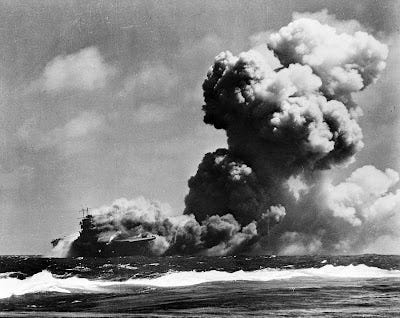I find it fun, and helpful, to read refreshed think pieces on carrier vulnerability like our friend and always pleasant read Robert Farley put out last week at 19fortyfive, The U.S. Navy’s Nightmare: 5 Ways To Kill An Aircraft Carrier.
From their very birth, carriers have been vulnerable. They are delicate but deadly creatures. Expensive to own and operate, but valuable beyond measure at war. Recall that one of the reason the Guadalcanal Campaign had so many surface actions was because there were just not that many carriers available to sustain casualties because ... well, they're vulnerable.
Everyone wants to kill them not just because they are so vulnerable, but because they are so useful. As Farley puts at the end of his article,
Aircraft carriers are instruments of geopolitical influence. As long as they serve usefully in that role, nations will seek means to neutralize them. The aircraft-carrier form has proven remarkably flexibly, serving in one way or another for nearly a hundred years. From the USS Forrestal on, the U.S. Navy supercarrier has existed in basically the same form since the 1950s, and is expected to continue operating into the latter half of the twenty-first century. At some point, the game will be up; carriers will no longer pack the offensive punch necessary to justify their vulnerability. It’s not obvious when that day will come, however; we may only find out after the destruction of one of the Navy’s prize possessions.
As almost all threats to carriers are evolutionary in nature - and I tend to be a bit immune to transformationalist hype - I see many of the "new" threats a few excitable people talk about accompanied with the requisite heavy breathing, as simply advances on known threats that will require an appropriate response in defense. No crisis, really ... however, there is one exception.
Farley is sound in this regard, and I encourage you to read it all, but here are 4 of the 5 ways to kill a carrier, and what I consider their evolutionally development from.
1. Undersea Unmanned Vehicles : SSK and sea mines.
2. Cyberattacks : Electronic Warfare and sabotage
3. Unmanned Aerial Vehicles : Old school Kamikaze mass attacks as in the Battle of Leyte Gulf
4. Hypersonic Weapons : Late Cold War ASCM delivered by SSGN & heavy bombers
For every threat - serious as they are - there is a countermeasure. I do wish more people will join the discussion that we need to plan to take losses and continue the fight - which is why we need more than 11 CVN, but one bite of the apple at a time, I guess.
That is 1-4, #5 is something, in a fashion, quite different.
5. Orbital bombardment systems (nicknamed “Rods from God”) can solve that problem. Satellites equipped with tungsten rods, or really any other kind of kinetic weapon, can simultaneously identify aircraft carriers and attack them, without messy problems associated with networked communications. The Rods from God, using kinetic energy alone, could deliver a tremendous blow to a surface target, either sinking a carrier or rendering it useless.
Many moons ago I has a 100# head type explain the math to me, and as Farley outlines, there are not many countermeasures one can have to this once someone launches those puppies downrange. They do have one vulnerability - they are in space and as such fragile (weight is a tax to get in orbit), and should be considered a first strike weapon. You have to get them before they go.
Unlike big-ass-balloons launched from Central China - you can't hide the rockets that will be needed to launch such weapons in to orbit and I have better than average confidence that Space Force will keep a close eye on those should they ever appear.
That weaponization of space would be a significant escalation globally. If done, that could be countered by "simple" anti-satellite weapons ... again, an escalation - but often you don't seek escalation; escalation seeks you.
Should #5 take place, the steps it would take to get us there informs me that we would have a lot more than just carrier security we would need to be focused on in the global security scene. No one is playing games when you weaponize near-Earth orbit.
The future would be interesting.
NB: I know many here save yourself the nightmare of twitter, so I just wanted to give everyone a heads up that there is a reason my posting here has been a bit light the last week - and perhaps a bit scattered - I am working my way through COVID. The worse it behind me, but I dodged it for three years, and it finally got me. I managed to recover well at home with minimum side effects besides a lack of appetite and an almost irresistible fatigue and desire to sleep. I will say this about COVID, except for the bone pain, it is worse than my previous worse malady, Dengue Fever. So, enough attention seeking for me. I do appreciate your patience as I attempt to get back up on step.





Covid isn't a joke, so get well soon.
Hope you continue on the mend sir! Keep up the good work!